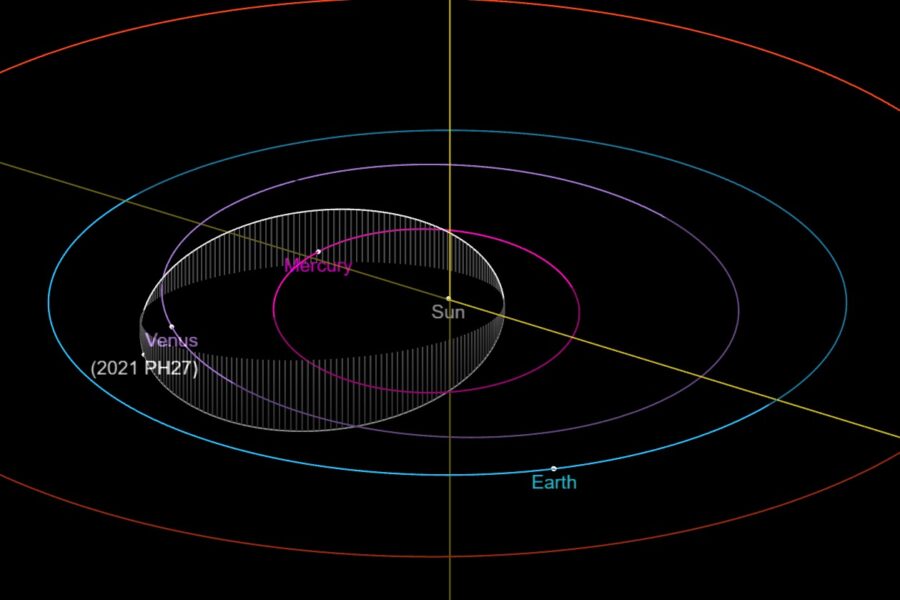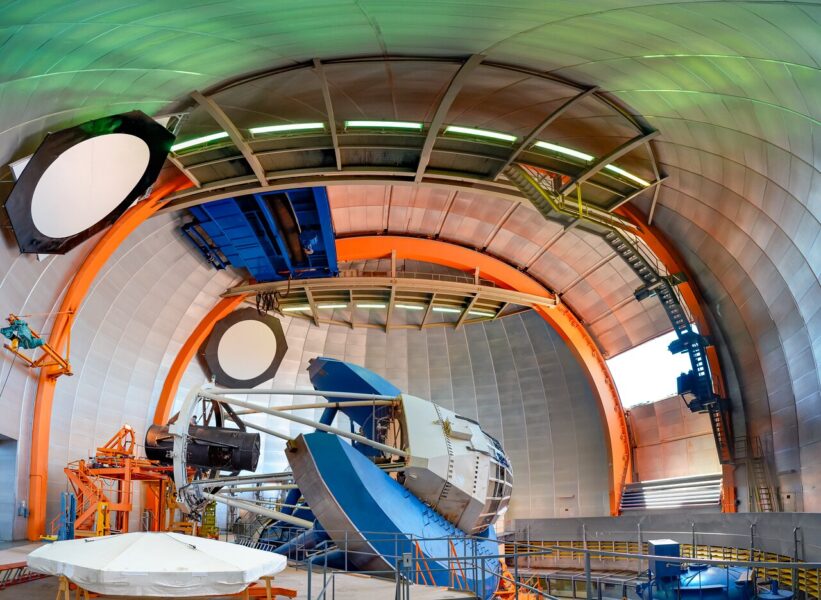27.08.2021
Newly discovered asteroid 2021 PH27 orbits the Sun in just 113 days.

There are new discoveries to be made, even in the inner solar system. This was highlighted this past week with the announcement of the discovery of tiny asteroid 2021 PH27. The asteroid orbits the Sun in just 113 days, the shortest orbital period for any known asteroid and the second shortest orbital period for any object in the solar system next to the planet Mercury, at 88 days.
The discovery was made by astronomer Scott S. Sheppard (Carnegie Institution for Science) after searching through images taken by Ian Dell’Antonio and Shenming Fu (both Brown University) at evening twilight on August 13, 2021. Subsequent observations with multiple telescopes around the world enabled astronomers to confirm the asteroid's orbit.

NASA / JPL
The initial discovery observations were made using the Dark Energy Camera (DECam) based at the National Science Foundation’s Blanco 4-meter telescope at the Cerro Tololo Inter-American Observatory (CTIO) complex in Chile. Although the primary mission for the Dark Energy Camera is the study of cosmic expansion, the Brown University astronomers agreed to use DECam at the beginning of their observing run to take wide-field images in the fading twilight.
"The Dark Energy Camera on the NSF's Blanco 4-meter telescope is one of the most powerful sky-survey imagers because of its large field of view — 2.2° wide, over four full Moons across — and the big telescope it is on," says Sheppard. "Because of this, I thought it would be interesting to observe during twilight with this powerful instrument, to go fainter than anyone has before in this region of the solar system."
Like fleeting Mercury, asteroids near the Sun are often bashful, appearing near the setting or rising Sun in twilight. Time on telescopes is often in short supply, and this discovery is a great example of using a survey already under way for multipurpose astronomy: Several astronomers agreed to interrupt their observing projects to enable the asteroid hunt.

FNAL / DOE / DECam / CTIO / NOIRLab / R. Hahn / NSF / Aura
"Telescope time for astronomers is very precious," says Sheppard in a recent press release. "The international nature and love of the unknown make astronomers very willing to override their own science and observations to follow up new, interesting discoveries like this."

CTIO / NOIRLab / NSF / Aura / D. Munizaga
THE STRANGE WORLD OF 2021 PH27
With a perihelion of just 0.137 astronomical unit (a.u.) (20.4 million kilometers, or 12.7 million miles) and an aphelion of 0.785 a.u., 2021 PH27 is a member of the rare class of Atira asteroids, with orbits entirely interior to Earth’s. Even at its closest approach to our planet (near the asteroid's aphelion), 2021 PH27 passes a good 0.215 a.u. from Earth. The asteroid also has the distinction of having the smallest orbit of any known asteroid: With a semi-major axis of only 0.46 a.u., 2021 PH27 beats out the former holder 2013 JX28 (semi-major axis of 0.6 a.u).
The asteroid has an absolute magnitude (its brightness at 1 a.u. away) of +17.7, suggesting it’s about a kilometer across. The surface of 2021 PH27 near perihelion reaches a blistering 480°C (900°F). Like rock-comet 3200 Phaethon, 2021 PH27 is either a captured asteroid or dormant comet nucleus. With an orbital inclination of 31.7° relative to the ecliptic, 2021 PH27 passes close to Venus on occasion; eventually, the second planet from the Sun may modify the asteroid's orbit or kick it out of the inner solar system entirely. (Asteroids in the inner solar system are generally not permanent guests.)

Brown University / DECam
The closest passage of 2021 PH27 near Venus for the coming decade will be 0.019 a.u. (2.9 million kilometers) next year on October 26, 2022. Keep in mind, though, that more observations of 2021 PH27 are needed to pin down its orbit: Astronomers were lucky to catch it just after aphelion on August 12th at a wide 35° east of the Sun, and the next favorable apparition isn’t until early 2022 at dawn, two orbits from now. By that time, the IAU may give the object a formal name, as well.
The discovery of 2021 PH27 is a tantalizing step towards finding possible members of an elusive class of hypothetical inter-Mercurial asteroids, known as Vulcanoids. The as-of-yet undiscovered class of asteroids takes its name from Vulcan, a theoretical world interior to the orbit of Mercury evoked by 19th-century astronomers to explain the anomalous orbital precession of Mercury's orbit. (Like Mercury, 2021 PH27 undergoes a sizable amount of orbital precession, thanks to the gravitational landscape it traverses near the Sun.) And though the advent of Einstein's general relativity in the early 20th century did away with the need for Vulcan to explain precession, the idea that a population of tiny (smaller than 1 kilometer across) asteroids orbiting entirely interior to Mercury’s orbit has not been ruled out.
Unfortunately, the effort to nab the first true Vulcanoid will have to wait for future surveys beyond DECam. "The telescope elevation limits prevent us from observing objects interior to Mercury," says Sheppard. "To date, looking for objects interior to Mercury has only been efficiently done through observations high up in Earth's atmosphere from airplanes, from spacecraft in space, or during solar eclipse events."
NASA’s Messenger spacecraft kept an electronic eye out for Vulcanoids en route to Mercury, and NASA also scoured the region near the Sun as part of the mission to chase the 2017 total solar eclipse with a pair of converted WB-57 bombers. Both surveys turned up empty.
2021 PH27 is an intriguing discovery, and may hint at more to come.
